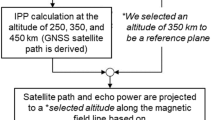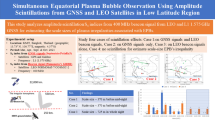Abstract
Radio wave propagation through space has been a topic of research for more than a century now. However, recent advancements in application of satellite navigation have generated renewed interest in this subject. Equatorial plasma bubble (EPB) is a unique phenomenon that occurs in equatorial and low latitude ionosphere during post sunset hours. Forecasting the hazardous effects of EPBs on trans-ionospheric electromagnetic signals is the current research problem. Global positioning system (GPS) signals, when pass through such irregularities, experience rapid fluctuations in phase and amplitude. The amplitude/phase fluctuations are called scintillations. Total delay of the signal due to ionospheric electron density can be represented as total electron content (TEC). The signal also exhibits steep changes in TEC during scintillations. Thus, the EPB manifest variations in scintillations and TEC in GPS signal. Using observation records from a dual frequency GPS Receiver ‘GSV4004B’ installed at Gadanki, both the parameters have been studied to find out the effect of EPBs on the signal.
Access this chapter
Tax calculation will be finalised at checkout
Purchases are for personal use only
Similar content being viewed by others
References
S.J. Adebiyi, O.O. Odeyemi, I.A. Adimula, O.A. Oladipo, S.O. Ikubanni, B.O. Adebesin, B.W. Joshua, GPS derived TEC and foF2 variability at an equatorial station and the performance of IRI-model. J. Adv. Space Res. 54(4):565–575 (2014)
S. Arunpold, N. Tripathi, R. Chowdhary, V.R. Chowdhary, D.K. Raju, Comparison of GPS-TEC measurements with IRI-2007 and IRI-2012 modeled TEC at an equatorial latitude station, Bangkok, Thailand. J. Atmos. Sol. Terr. Phys. 117, 88–94 (2014)
P.K. Bhuyan, R. Hazarika, GPS TEC near the crest of the EIA at 95E during the ascending half of solar cycle 24 and comparison with IRI simulations. Adv. Space Res. 52(7), 1247–1260 (2013)
D. Bilitza, D. Altadill, Y. Zhang, C. Mertens, V. Truhlik, P. Richards, L.A. McKinnell, B. Reinisch, The International Reference Ionosphere 2012–a model of international collaboration. J. Space Weather Space Clim. 4(A07), 1–12 (2014)
A.A. Chernyshov, D.V. Chugunin, M.M. Mogilevsky, A.A. Petrukovich, Studies of the ionosphere using radiophysical methods on ultra-small spacecrafts. Acta Astronaut. 167, 455–459 (2020)
N. Dashora, R. Pandey, Observation in equatorial anomaly region of total electron content enhancements and depletion. Ann. Geophys. (EGU) 23, 2449–2456 (2005)
J. Feltens, M. Angling, N. Jackson-Booth, N. Jakowski, M. Hoque, M. Hernández-Pajares, Á. Aragón, Á. María, R. Orús-Pérez, Comparative testing of four ionospheric models driven with GPS measurements. Radio Sci. 46(6), RS0D12 (2011)
R. Jin, S. Jin, G. Feng, M_DCB: Matlab code for estimating GNSS satellite and receiver differential code biases. GPS Solut. 16(4), 541–548 (2012)
R. Kakoty, S. Bora, P.K. Bhuyan, Spatial asymmetry in topside ion density and vertical E × B plasma drift velocity within 75°E–95°E. Adv. in Space Res. 63(3), 1176–1191 (2019)
S.P. Karia, N.C. Patel, K.N. Pathak, Comparison of GPS based TEC measurements with the IRI-2012 Model for the period of low to moderate solar activity (2009–2012) at the crest of equatorial anomaly in Indian region. Adv. Space Res. 55(8), 1965–1975 (2015)
H.B. Lee, G. Jee, Y.H. Kim, J.S. Shim, Characteristics of global plasmaspheric TEC in comparison with the ionosphere simultaneously observed by Jason-1 satellite. J. Geophys. Res. 118(2), 935–946 (2013)
S.K. Leong, T.A. Musa, K. Omar, M.D. Subari, N.B. Pathy, M.F. Asilam, Assessment of ionosphere models at Banting: Performance of IRI- 2007, IRI-2012 and Ne-Quick 2 models during the ascending phase of Solar Cycle 24. J. Adv. Space Res. 55(8), 1928–1940 (2015)
Z. Li, Y. Yuan, N. Wang, M. Hernandez-Pajares, X. Huo, SHPTS: towards a new method for generating precise global ionospheric TEC map based on spherical harmonic and generalized trigonometric series functions. J. Geodesy 89(4), 331–345 (2015)
C.H. Lin, J.Y. Liu, H.F. Tsai, C.Z. Cheng, Variations of the equatorial ionization anomaly peaks in the west pacific region during the April 6 and July 15, 2000 geomagnetic storms. Earth Planets Space 59(5), 401–405 (2007)
K. Liu, G. Li, B. Ning, Possible evidence for small-scale wave seeding of equatorial plasma bubbles. Adv. Space Res. 63(11), 3612–3620 (2019)
W. Luo, Z. Liu, M. Li, A preliminary evaluation of the performance of multiple ionospheric models in low- and mid-latitude regions of China in 2010–2011. GPS Solut. 18(2), 297–308 (2014)
O.A. Maltseva, N.S. Mozhaeva, O.S. Poltavsky, G.A. Zhbankov, Use of TEC global maps and the IRI model to study ionospheric response to geomagnetic disturbances. Adv. Space Res. 49(6), 1076–1087 (2012)
D. Okoh, L. McKinnell, P. Cilliers, P. Okeke, Using GPS-TEC data to calibrate VTEC computed with the IRI model over Nigeria. Adv. Space Res. 52(10), 1791–1797 (2013)
S.K. Panda, S.S. Gedam, G. Rajaram, Study of Ionospheric TEC from GPS observations and comparisons with IRI and SPIM model predictions in the low latitude anomaly Indian sub continental region. J. Adv. Space Res. 55(8), 1948–1964 (2015)
A.B. Rabiu, A.O. Adewale, R.B. Abdulrahim, E.O. Oyeyemi, TEC derived from some GPS stations in Nigeria and comparison with the IRI and Ne Quick models. J. Adv. Space Res. 53(9), 1290–1303 (2014)
S. Sau, V.L. Narayanan, Gurubaran S., K. Emperumal, Study of wave signatures observed in thermospheric airglow imaging over the dip equatorial region. Adv. Space Res. 62(7), 1762–1774 (2018)
L.A. Scidá, R.G. Ezquer, M.A. Cabrera, M. Mosert, C. Brunini, D. Buresova, On the IRI 2007 performance as a TEC predictor for the South American sector. J. Atmos. Sol. Terr. Phys. 81–82, 50–58 (2012)
A.K. Sharma, O.B. Gurav, G.A. Chavan, H.P. Gaikwad, R.N. Ghodpage, P.T. Patil, Variation in occurrence of equatorial plasma bubbles (EPBs) using All Sky Imager from low latitude station Kolhapur (16.8 °N, 74.2 °E, 10.6° dip. Lat.). Adv. Space Res. 60(11), 2452–2463 (2017)
V.K.D. Srinivasu, N. Dashora, D.S.V.V.D. Prasad, N. Niranjan, S. Gopi Krishna, On the occurrence and strength of multi-frequency multi-GNSS Ionospheric Scintillations in Indian sector during declining phase of solar cycle 24. Adv. Space Res. 61(7), 1761–1775 (2018)
Y. Xiang, Y. Yuan, Z. Li, N. Wang, Analysis and validation of different global ionospheric maps (GIMs) over China. J. Adv. Space Res. 55(1), 199–210 (2015)
A.E. Yeboah, I. Paulino, A.F. Medeiros, R.A. Buriti, C.M. Wrasse, Seasonal variation of plasma bubbles during solar cycle 23–24 over the Brazilian equatorial region. Adv. Space Res. 64(7), 1365–1374 (2019)
I.E. Zakharenkova, IuV Cherniak, A. Krankowski, I.I. Shagimuratov, Vertical TEC representation by IRI 2012 and IRI Plas models for European mid latitudes. J. Adv. Space Res. 55(8), 2070–2076 (2015)
Acknowledgements
The corresponding author is thankful to Director, National Atmospheric Research Laboratory (NARL), Gadanki, Andhra Pradesh (India) for providing necessary experimental facilities for GPS measurements. Fruitful discussions with his colleague scientists to prepare and improve the manuscript are highly grateful and acknowledged.
Author information
Authors and Affiliations
Corresponding author
Editor information
Editors and Affiliations
Rights and permissions
Copyright information
© 2020 The Editor(s) (if applicable) and The Author(s), under exclusive license to Springer Nature Singapore Pte Ltd.
About this paper
Cite this paper
Kumar, A. (2020). GPS Device Based Equatorial Plasma Bubbles (EPB) Analysis on Radio Wave Propagation Over Low Latitude. In: Jain, V.K., Rattan, S., Verma, A. (eds) Recent Trends in Materials and Devices. Springer Proceedings in Physics, vol 256. Springer, Singapore. https://doi.org/10.1007/978-981-15-8625-5_16
Download citation
DOI: https://doi.org/10.1007/978-981-15-8625-5_16
Published:
Publisher Name: Springer, Singapore
Print ISBN: 978-981-15-8624-8
Online ISBN: 978-981-15-8625-5
eBook Packages: Physics and AstronomyPhysics and Astronomy (R0)




